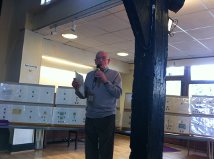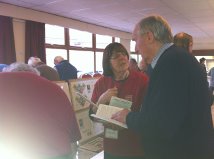Tony Burbidge kicked off the afternoon with an interesting introduction to the early geographical history of the island of St Vincent, part of the Windward Isles. He then presented the Postal history of the Island including a copy of the rare Fleuron type postmark on cover, before going on to explain the various early printings, perforations, watermarks etc., of the original Perkins Bacon issues. He ended his fine display with a full and detailed presentation of the De la Rue issues. It was a delight to see this material, and many members remarked on the excellent condition of the items on display.
Julie Webb was next up and despite some early misgivings (this was her first ever presentation to an audience, albeit a very friendly one) Julie gave us an excellent presentation on the stamps & coins of the Lundy Isles (often referred to as the Puffin Isles). After a brief overview of the history of the independent postal system of Lundy, instigated in 1925 by Martin Coles Harmen, Julie then went on to give us a very informed report on the plight of the Puffin itself. We learned that from a breeding colony of some 3,000 pairs, first reported in 1939, the introduction of the brown rat to the island reduced the Puffin population to the almost extinct state of only 5 pairs. However, she explained by exterminating the rats, the colony seems to be in recovery, albeit slowly, with 16 pairs recorded in 2010 and 80 individual birds recorded in 2013.
The Vice-Chairman, Ken Willmott closed the first half with a display of the not so lucky Monarch butterfly, whose numbers are in desperate decline mostly due to the deforestation of its overwintering habitat in Mexico. Ken gave us a very interesting overview of the migratory habits of this beautiful species, which annually fly thousands of miles from North America (Canada) to the southern climes of Mexico. He displayed some of the amazing material he has in his collection, both of a philatelic and non-philatelic nature including a delightful FDC from Canada depicting several (all female, he noted) Monarchs and her caterpillars. On a brighter note he pointed out a cover and stamps produced by the World Wildlife Fund (WWW) depicting the lifecycle of the Monarch, which were sold in aid of the WWW and to help with their work in saving this magnificent species from extinction.
David Bravery opened the second half of the afternoon with an outstanding display of stamps, postcards, postmarks, and ephemera of the Bay of Cattaro, a little known southern extremity of the Austrian Empire. Concentrating on the history of the area, David’s talk was fascinating in his presentation of little known facts; for example many in the audience were surprised that Austria, an entirely land-locked area, maintained a very large and successful Navy, based on the Adriatic, and from 1850 Cattarro was a Military Harbour. It was also a popular holiday resort as portrayed in many of the delightful pictorial postcards on display. On a darker side, Cattarro was used as an important submarine base during WW1, with its easy access to the Mediterranean making it the ideal venue. David explained that mail from these submarines was very difficult to obtain, but some of the letters and cards in his collection gave excellent contemporary accounts of the hardships and deprivations these mariners had to endure. Not only a fine collection the philatelic elements, but also with David’s informed and entertaining narration, a wonderful account of social history of the time.
Julia Todd followed on in much the same vein in that she gave us a very entertaining thematic overview of the Island of Monserrat, a Caribbean island forming part of the Leeward Islands. Starting with early geographical history and the native bow hunting Caribs (from whom the area was officially named), Julia gave us an interesting tour of this beautiful but unlucky island. Recently plagued by two major disasters, the first in 1989 being the devastating Hurricane ‘Hugo’, and then followed by the even more disastrous Volcano eruption in 1995, which left almost two thirds of the island lying under many feet of volcanic dust. Julia explained how the postage stamps and philatelic items of the Island formed vital revenue for this blighted area. She pointed out some of the stamps that had been overprinted with a surcharge in aid of the ongoing relief work, to try to rehabilitate and regenerate the island.
John Lea took the afternoon’s opportunity to re-acquaint many of us with the once familiar stamps, often sold in packets from outlets such as Smith’s and corner shop retailers, to furnish the pages of many schoolboy albums and collections. These stamps, although often crudely produced, were usually made up from some 3-4 designs covering some 15 or so values. Forming a substantial part of the French Colonies issues from the late 19th and early 20th century, many of the Colonies had an interesting political history during WW2, including those issued for French Oceana (now more familiarly known as French Polynesia covering and area between Australia and South America). Torn between the German influenced Vichy Government of Petain and the Free French Government of the exiled General De Gaulle, French Oceana opted to support De Gaulle, and their stamps of the era reflect this decision. John never fails to surprise with his in-depth knowledge in so many philatelic areas and this fascinating display was of no exception.
Michael Lockton rounded off a wonderful afternoon, treating us to the background and development of the introduction and implementation of GB ‘Compulsory Registration’. He informed us that although Registration of valuable items had been in force since 1841, it was not until 1863, under the recommendation of Rowland Hill, that Compulsory Registration ie. items posted out of course, would be surcharged. Michael went on to explain the three reasons when this charge would be incurred: 1) When Registration had been noted on the cover, but not paid for. 2) When two blue lines forming a cross had been drawn on the cover, but again no fee paid. And 3) when the letter contained coins (often referred to as coin letters). Many examples of these instances were included in the display, many with the surcharge collected using Postage Due stamps and a label on the reverse indicating why the charge had been incurred. As we have come to expect from Michael, this was a well informed and illustrated presentation which covered an area often neglected and even sometimes misunderstood by many collectors.
Steve Paice did an excellent job introducing the exhibitors and generally keeping the afternoon’s proceedings on time.





